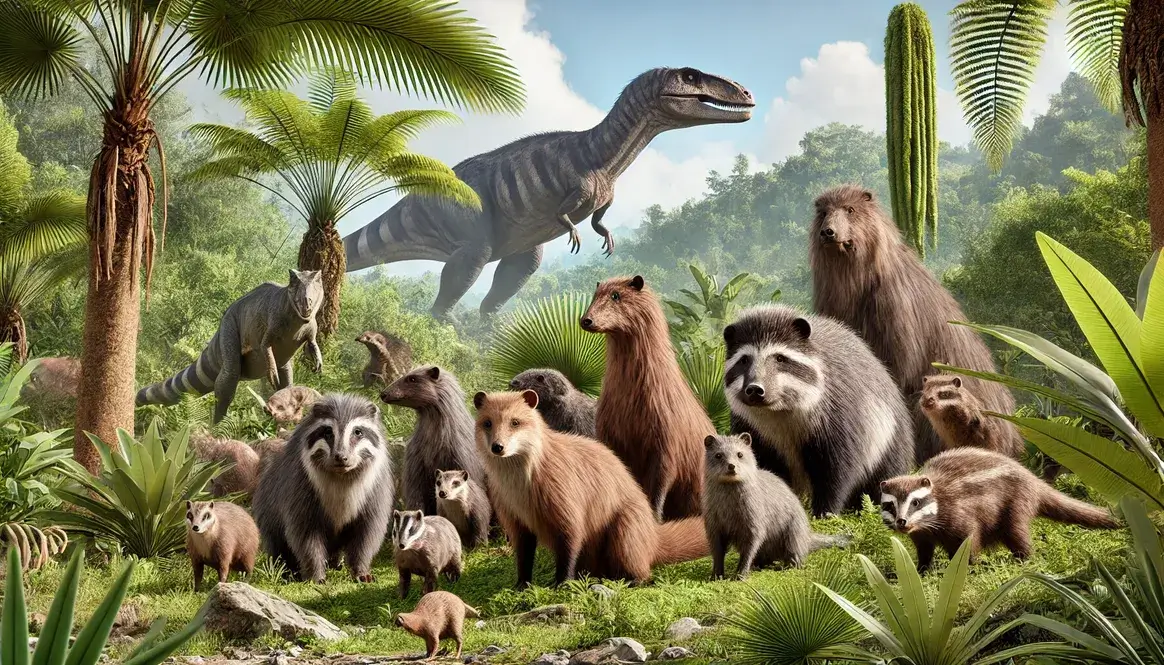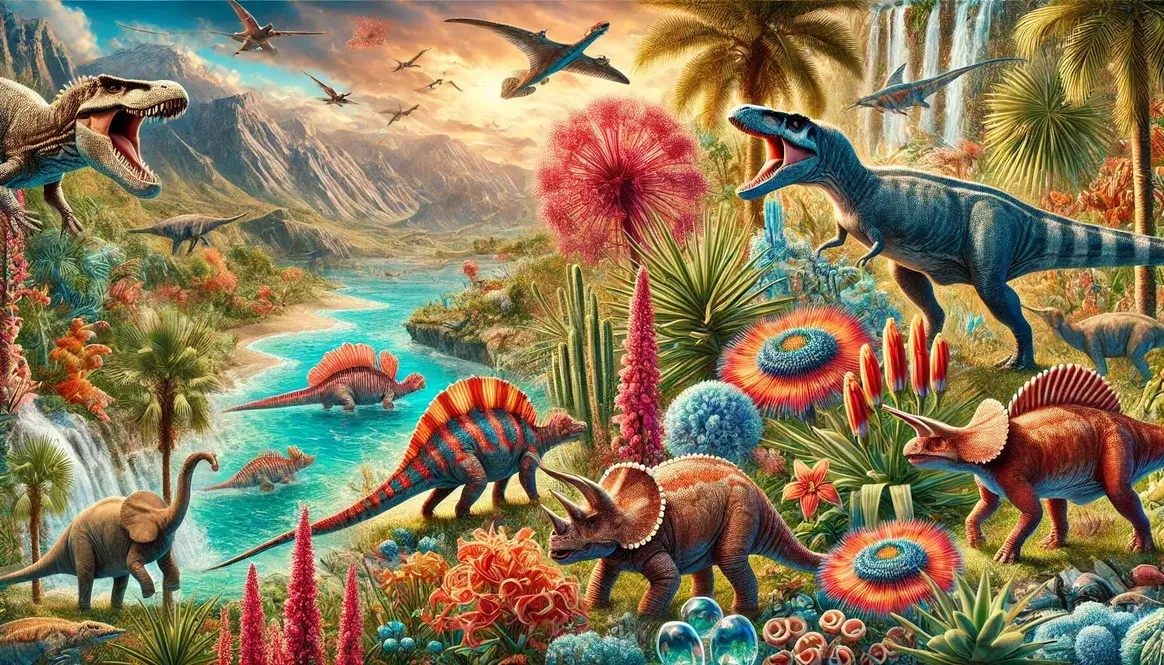Long before the first flowers bloomed, the Earth was covered in lush forests of ferns, conifers, and other non-flowering plants. These ancient plants had been around for millions of years, dominating the landscape during the time of the dinosaurs. But about 135 million years ago, during the Early Cretaceous period, something extraordinary happened: the first flowering plants, or angiosperms, emerged.
The appearance of flowering plants was a game-changer for life on Earth. These new plants would eventually transform ecosystems, provide new food sources for animals, and set the stage for the incredible diversity of plant life we see today.
Scientists estimate that the first angiosperms evolved sometime between 140 and 130 million years ago. While pinpointing the exact moment is tricky, fossil evidence gives us clues about when these revolutionary plants first appeared.
The earliest known fossil evidence of flowering plants comes from the Early Cretaceous period. One of the most famous early angiosperm fossils is Archaefructus liaoningensis, discovered in China. This 125-million-year-old fossil shows a primitive flower with simple parts, giving us a glimpse into what the first flowering plants might have looked like.
First Flowering Plants: Primitive Beginnings
The earliest flowering plants were quite different from the colorful blooms we see today. They were small, with simple flowers that lacked the complex structures found in modern plants. Here are some key characteristics of these primitive angiosperms:
- Small size: Early flowering plants were often small herbs or shrubs.
- Simple flowers: The flowers had fewer parts and were less specialized than modern flowers.
- Separate male and female flowers: Many early angiosperms had unisexual flowers, unlike the perfect (hermaphroditic) flowers common in many modern species.
- Lack of petals: Some early flowers may have lacked true petals, instead having petal-like structures called tepals.
Examples of early flowering plant species include:
| Species | Age (million years) | Notable Features |
|---|---|---|
| Archaefructus liaoningensis | 125 | Aquatic plant with simple flowers |
| Monetianthus mirus | 115 | Tiny flowers with curved fruits |
| Leefructus mirus | 125 | Primitive flower with leaf-like sepals |
When compared to their contemporary non-flowering plants, these early angiosperms had some distinct advantages:
- Faster reproductive cycle: Angiosperms could produce seeds more quickly than gymnosperms (non-flowering seed plants like conifers).
- More efficient water transport: They developed more advanced vascular systems, allowing for better water and nutrient distribution.
- Adaptability: Early flowering plants could quickly adapt to new environments, helping them spread and diversify.
While these first flowering plants might seem unremarkable compared to today’s diverse and showy blooms, they set the stage for a botanical revolution that would change the face of the planet.
Key Adaptations: Innovations in Plant Biology
The first flowering plants brought a suite of innovative features that gave them a competitive edge over their non-flowering counterparts. These adaptations would prove crucial in their rapid spread and diversification across the globe.
Flower Structure and Function
Early flowers were simple yet revolutionary. They consisted of several key parts:
- Stamens: The male reproductive organs that produce pollen
- Carpels: The female structures containing ovules
- Tepals: Petal-like structures that protected the reproductive parts
These basic floral components worked together to achieve something remarkable: more efficient reproduction. The flower’s primary purpose was to facilitate pollination and seed production. By concentrating reproductive organs in one structure, flowering plants increased their chances of successful fertilization.
Flowers also developed colorful tepals and produced nectar, attracting insects and other animals. This mutually beneficial relationship between plants and pollinators would become one of the most successful partnerships in nature, driving the evolution of both groups.
Efficient Water Transport
One of the most significant innovations of early angiosperms was their advanced vascular system. This internal plumbing allowed for more efficient transport of water and nutrients throughout the plant.
Key developments included:
- Vessel elements: These specialized cells formed long, uninterrupted tubes for water transport.
- Improved xylem structure: The water-conducting tissue became more efficient at moving water upwards.
- Enhanced phloem: This tissue distributed sugars and other nutrients more effectively.
These adaptations gave flowering plants a significant advantage over earlier plant groups. They could grow taller, transport water more efficiently in dry conditions, and distribute nutrients more effectively to all parts of the plant.
Rapid Reproduction and Growth
Perhaps the most game-changing adaptation of the first flowering plants was their ability to reproduce and grow rapidly. This gave them a significant edge in colonizing new environments and adapting to changing conditions.
| Characteristic | Angiosperms | Gymnosperms |
|---|---|---|
| Life cycle | Weeks to months | Years to decades |
| Seed production | Abundant | Limited |
| Growth rate | Rapid | Slow |
Angiosperms could complete their life cycles in a fraction of the time it took gymnosperms. This meant they could:
- Produce multiple generations in a single growing season
- Quickly adapt to new environments through natural selection
- Outcompete slower-growing plants in disturbed habitats
These rapid life cycles, combined with their other adaptations, allowed the first flowering plants to spread across diverse Cretaceous landscapes, setting the stage for their eventual dominance of terrestrial ecosystems.
Mid-Cretaceous Diversification: Angiosperm Expansion
As the Cretaceous period progressed, flowering plants underwent a remarkable expansion. This era saw a dramatic increase in angiosperm diversity and abundance, transforming the Cretaceous landscapes in ways that would shape the future of terrestrial ecosystems.
The rapid diversification of angiosperms allowed them to spread into various ecological niches. From lush forests to arid regions, flowering plants adapted to an array of environments, each developing unique characteristics to thrive in their new homes.
Some notable flowering plant groups that emerged during this time include:
- Magnoliids: Early flowering plants with primitive features
- Monocots: Plants with single seed leaves, including early grasses
- Eudicots: The largest group of flowering plants, including many modern families
This diversification had far-reaching effects on the Cretaceous world. New plant types provided novel food sources for herbivorous dinosaurs, influencing their evolution. The changing plant communities also altered habitats, creating new opportunities for animal life.
Coevolution with Insects: A Mutualistic Revolution
The rise of flowering plants was intimately linked with the evolution of insects. This partnership would become one of nature’s most successful collaborations, driving the diversification of both groups.
Early Pollinators
Early pollinators played a crucial role in the success of the first flowering plants. These insect partners included:
- Beetles: Among the earliest pollinators, attracted to pollen as a food source
- Flies: Drawn to the odors produced by some early flowers
- Early bees: Specialized pollinators that coevolved with flowering plants
These insects developed various adaptations for pollen collection:
| Insect Group | Adaptations |
|---|---|
| Beetles | Mandibles for chewing pollen |
| Flies | Sticky body hairs to trap pollen |
| Bees | Specialized pollen baskets on legs |
Floral Adaptations for Insect Attraction
As insects became more important for pollination, flowers evolved to attract them more effectively. This led to the development of:
- Colors: Bright hues to catch the eye of flying insects
- Shapes: Forms that facilitated insect landing and pollen transfer
- Scents: Aromatic compounds to attract pollinators from a distance
Perhaps the most significant adaptation was the production of nectar. This sugary liquid served as a reward for pollinators, ensuring they would return to the same species of flower repeatedly. This mutually beneficial relationship drove the coevolution of flowers and insects, leading to increasingly complex and specialized interactions.
The partnership between flowering plants and insects had profound effects on the Cretaceous ecosystem. It accelerated the diversification of both groups, creating a burst of evolutionary innovation that would shape the future of terrestrial life.
Transforming Ecosystems: Impact on Cretaceous Life
The rise of flowering plants during the Cretaceous period brought about significant changes to the world’s ecosystems. These changes had far-reaching effects on both plant and animal life, reshaping the landscape of our planet.
Changes in Plant Communities
As angiosperms spread and diversified, they began to replace the gymnosperm-dominated forests that had characterized earlier periods. This transition didn’t happen overnight; it was a gradual process that unfolded over millions of years.
The shift in plant communities can be summarized as follows:
- Early Cretaceous: Gymnosperms (like conifers and cycads) dominated
- Mid-Cretaceous: Angiosperms began to appear and spread
- Late Cretaceous: Flowering plants became increasingly prevalent
This change in plant life created new habitats and ecological niches. Flowering plants introduced novel structures like fruits and flowers, which provided new food sources and shelter for various animals. They also altered the physical structure of forests, creating more diverse and complex environments.
Some of the new habitats created by flowering plants included:
- Dense understory vegetation in forests
- Meadows and grasslands (as early grasses evolved)
- Wetlands dominated by aquatic angiosperms
These new environments provided opportunities for animals to evolve and adapt, contributing to the rich biodiversity of the Cretaceous period.
Effects on Herbivorous Dinosaurs
The spread of flowering plants had a profound impact on herbivorous dinosaurs. These animals, which had evolved to feed on gymnosperms and other non-flowering plants, now faced a changing menu.
Many herbivorous dinosaurs developed adaptations to take advantage of these new food sources. For example:
- Dental adaptations: Some dinosaurs evolved more complex tooth structures to process the tougher leaves of some angiosperms.
- Jaw modifications: Certain species developed more flexible jaw joints to handle the varied textures of flowering plants.
- Digestive changes: It’s likely that some dinosaurs evolved new gut bacteria to help break down novel plant compounds.
The introduction of fruits and flowers also provided new nutritional opportunities. Some dinosaurs may have developed preferences for these energy-rich food sources, potentially influencing their behavior and ecology.
The diversification of plant life may have also contributed to increased dinosaur diversity. As new plant species emerged, they created opportunities for dinosaurs to specialize in different diets. This could have driven the evolution of new dinosaur species adapted to specific plant types or habitats.
However, it’s important to note that the relationship between plant and dinosaur diversity is complex. While flowering plants likely influenced dinosaur evolution, other factors such as climate change and Cretaceous predators also played crucial roles in shaping dinosaur diversity.
Late Cretaceous Dominance: Angiosperms Ascendant
By the Late Cretaceous, flowering plants had firmly established themselves as the dominant plant group on Earth. This ascendancy marked a turning point in the history of terrestrial life, setting the stage for the incredible diversity of plant life we see today.
The success of angiosperms during this period can be attributed to several factors:
- Rapid adaptation to diverse environments
- Efficient reproduction strategies
- Coevolution with pollinators and seed dispersers
As flowering plants became more prevalent, they continued to evolve and diversify. This period saw the development of more complex and specialized flower structures. Flowers began to exhibit a wide range of shapes, sizes, and colors, each adapted to attract specific pollinators or deter herbivores.
Some notable developments in flower structure included:
- Fusion of floral parts: Leading to more complex flower shapes
- Bilateral symmetry: Allowing for more precise pollinator interactions
- Specialized pollination mechanisms: Such as trigger flowers or trap flowers
The Late Cretaceous also witnessed the emergence of early fruit-bearing plants. These plants produced fleshy fruits that encased their seeds, providing nutrition for the developing embryo and attracting animals that could disperse the seeds. This innovation would prove to be a game-changer, leading to new ecological relationships and dispersal strategies.
| Fruit Type | Example | Dispersal Method |
|---|---|---|
| Berries | Early Vitaceae (grape family) | Animal ingestion |
| Drupes | Primitive stone fruits | Animal ingestion |
| Dry fruits | Early legumes | Wind or animal transport |
These Cretaceous innovations in plant biology would have far-reaching effects on ecosystems, influencing the evolution of both plants and animals for millions of years to come.
Legacy of the First Flowering Plants
The emergence of the first flowering plants in the Early Cretaceous set in motion a botanical revolution that continues to shape our world today. Angiosperms now dominate terrestrial ecosystems, comprising the majority of plant species and playing crucial roles in nearly every habitat on Earth.
The importance of flowering plants in modern ecosystems cannot be overstated:
- They form the base of most terrestrial food webs
- They play key roles in water and nutrient cycling
- Many provide essential ecosystem services like pollination and soil stabilization
Moreover, humans rely heavily on angiosperms for food, medicine, building materials, and countless other resources.
Research into the origins and early evolution of flowering plants remains an active and exciting field of study. Recent discoveries continue to shed light on the early history of angiosperms:
- Fossil finds: New fossils are constantly being unearthed, providing glimpses into early angiosperm diversity.
- Molecular studies: Advanced genetic analyses are helping to refine our understanding of angiosperm evolutionary relationships.
- Paleoecological reconstructions: Interdisciplinary studies are revealing more about the environments in which early angiosperms evolved.
Looking to the future, several key questions continue to drive research in this field:
- What were the exact environmental conditions that favored the rise of angiosperms?
- How did the earliest flowering plants interact with Cretaceous animals, including dinosaurs?
- Can we identify the closest living relatives of the first angiosperms?
As we continue to unravel the mysteries of the first flowering plants, we gain not only a better understanding of Earth’s past but also valuable insights into plant evolution and ecology that could inform conservation efforts and agricultural practices in our changing world.









